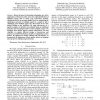Free Online Productivity Tools
i2Speak
i2Symbol
i2OCR
iTex2Img
iWeb2Print
iWeb2Shot
i2Type
iPdf2Split
iPdf2Merge
i2Bopomofo
i2Arabic
i2Style
i2Image
i2PDF
iLatex2Rtf
Sci2ools
BIBE
2010
IEEE
2010
IEEE
Methods for Designing Reliable Probe Arrays
Recent advances in biosensing technologies have led to applications of biosensor probe arrays for rapid identification of biological agents such as drugs, gene expressions, proteins, cholesterol and fats in an input sample. However, monitoring the simultaneous presence of multiple agents in a sample is still a challenging task. Multiple agents may often attach to the same probes, leading to low specificity. By using microarrays as a specific example, we introduce two methods based on conditional deduction and non-unique probes to detect multiple targets. We introduce three quality metrics, namely: effectiveness, cost and reliability to evaluate different designs of microarrays and propose two ILP/Pseudo-Boolean models for optimizing on these metrics. By applying on various synthetic and real datasets, we demonstrate the importance of these quality metrics in designing microarrays for multiple target detections. Microarrays; Probe based sensors; Optimization; ILP; SAT
Related Content
| Added | 08 Nov 2010 |
| Updated | 08 Nov 2010 |
| Type | Conference |
| Year | 2010 |
| Where | BIBE |
| Authors | Michele Lombardi, Luca Benini, Abhishek Garg, Giovanni De Micheli |
Comments (0)

